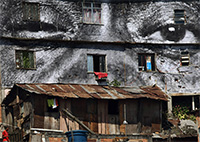 “Slum Tourism” – according to Wikipedia is “a type of tourism that involves visiting impoverished areas to see and understand how the other side lives”. It has also been referred to as “Poverty Tourism”, “Poorism” and “Slumming” In the simplest terms – it’s visiting a specific location for the express purpose of ‘seeing’ how humans live in impoverished conditions. It’s not for instance, traveling and stumbling onto one of the worst ghettos in the world – the arrival wasn’t intended. The key to Slum Tourism is intent – one is going specifically to see impoverished conditions – usually with camera in tow.
“Slum Tourism” – according to Wikipedia is “a type of tourism that involves visiting impoverished areas to see and understand how the other side lives”. It has also been referred to as “Poverty Tourism”, “Poorism” and “Slumming” In the simplest terms – it’s visiting a specific location for the express purpose of ‘seeing’ how humans live in impoverished conditions. It’s not for instance, traveling and stumbling onto one of the worst ghettos in the world – the arrival wasn’t intended. The key to Slum Tourism is intent – one is going specifically to see impoverished conditions – usually with camera in tow.
What some say is a valid way to learn about one’s self, another culture and possibly contribute in some way to that community’s plight; others see as an almost evil form of voyeurism in which the supposed benefits can be derived from direct contribution – either via money or labor – without the dignity robbing picture taking. To add insult to injury, there are plenty of for profit businesses that make money providing organized ‘tours’ of these locations – some have been accused of not giving any money back to the communities they are taking advantage of.
So is Slum Tourism a Bad Thing?
First off, such a negative term is bound to cause a disapproving reaction when first hearing it. Of course those who go on these excursions or promote and make money off them don’t use this terminology and feel they are unfairly targeted. Even if you prefer the more diplomatic “Impoverished Areas Tour”, I’ve listed a few reasons why some choose to go on these types of excursions:
- Social Awareness – Understanding how other parts of the world live allows you to put your current situation into perspective. Throwing a hissy fit when the waiter puts the wrong dressing on you salad seems a bit silly when others are eating out of the public dump or sleeping in dirt floor huts with no inside plumbing. In addition, getting first-hand knowledge about any subject is always better that someone else’s interpretation. You can’t talk about changing the world if you’ve never actually been to the part of the world you are trying to change (it’s a credibility kinda thing).
- Help That Community – Whether visiting on your own or as part of an organized tour, the money you spend may end up in the community. Buying crafts from a local vendor or eating at a restaurant puts money directly into the hands of those that need it the most. Obviously, direct contributions such as building homes, teaching at the local school, etc. are excellent ways to help the community – but that’s generally called “Volunteerism” e.g., you are staying for a bit – not leaving after you’ve gotten enough pictures.
- Feel Better About One’s Self – Allows one to feel better about their relatively good lives and thank whomever they pray to for not been born in such conditions. I know that sounds harsh to say, but we all know people who are not happy unless they feel superior to others.
- Spreading the Word – Slums aren’t something that’s generally on the news or on television unless there have famous advocates, ala Sally Struthers in the 80s or George Clooney. There is a strong correlation between those who’ve personally seen some of these conditions and have become advocates with the amount of monetary support received for that cause from individuals, communities and nations.
- Historical Significance – While South Africa’s Soweto community just outside of Johannesburg is nowhere as bad as it used to be, it is slowly emerging from the oppression of the Apartheid era and the years of neglect, poverty and crime since its fall. In my opinion, you really have to ‘see’ the bullet holes in Mandela’s house and dirt floor homes to truly understand how far they’ve come and how far the community has to go.
 Now, reasonable people can debate the validity of the statements above but those are the driving forces as I see (have heard) them. The most popular of the so called “Slum Tours” are conducted in Mumbai, India (think Slumdog Millionaire). Rio de Janeiro, Brazil, Soweto/Johannesburg, South Africa and very recently Port a Prince, Haiti and New Orleans, USA. The counter arguments as to why one should skip these kinds of tours are as follows:
Now, reasonable people can debate the validity of the statements above but those are the driving forces as I see (have heard) them. The most popular of the so called “Slum Tours” are conducted in Mumbai, India (think Slumdog Millionaire). Rio de Janeiro, Brazil, Soweto/Johannesburg, South Africa and very recently Port a Prince, Haiti and New Orleans, USA. The counter arguments as to why one should skip these kinds of tours are as follows:
- No Human Zoos – Perhaps the most damming reason not to do participate in so-called slum tours is to think of how the person you are ‘viewing’ feels about your presence. What if someone walked into your house and took pictures of your dirty closest and posted them on their blog/Facebook for all of their friends to see, laugh and feel better about themselves? There is no such thing as a Human Zoo – so taking snapshots of people struggling in their everyday lives is just awful.
- Can’t Truly Understand – The world is an increasing small place – pick up a book, watch TV or research on the Internet if your goal is to learn something. By all means, volunteer if you really want to help someone. But at the end of the day – you can’t truly understand what it’s like to be in their position by taking any kind of tour. Taking a tour to understand the plight of struggling people is like watching the Special Olympics to understand what it’s like to be a paraplegic. You can certainly conceptualize and have strong feelings about their plight – but you can leave – they can’t.
- Not a fair trade – What exactly do the subjects get out of these tours? Many of these so called tour companies have been accused to making money off of human poverty but not doing anything to help those who are the source of their revenue. You can see the conflict of interest right – if there was no slum, there be no slum tour business. If you aren’t directly contributing in some way then you are participating in a human zoo.
This isn’t cable news; I’m not going to tell you whether you should or shouldn’t do something – my goal is to provide a little perspective so you can make your own decision. My opinion is – you can’t really know (or talk about it) if you haven’t seen it yourself.
Some rules please
If you decide to visit an impoverished area, I think you have to follow some minimum levels of respect and decency while you are engaged. In addition, poverty breeds crime – so watching out for your own personal safety is key.
- You aren’t at a zoo! Don’t take pictures of people or their property without their permission. If in doubt, ask yourself before you take that picture if you were the person on the other end – how would you feel.
- Try not to go alone. Every person you encounter in the world isn’t decent; there are robbers, rapist and murderers in every walk of life and social economic class. A “tour” isn’t necessary, but there is strength and safety in numbers. Also, going into these areas at night is generally a bad idea.
- If you can’t blend in (admittedly a difficult thing to do in many cases) – at least try not to be obnoxious in flaunting your relative wealth. Lose the jewelry, designer fashions and the annoying electronic gizmos.
- Even better – contribute to the situation – either volunteer or buy something directly from a street vendor. This way, you know your time spent there has garnered some tangible benefit to someone’s life – albeit fairly small in the scheme of things.
- If you go the “tour” route, try to choose a company that purports to re-invest at least some of the proceeds of their tours back into the community you are viewing. Of course there’s little way you can validate these types of claims – but at least go for the ones that have done the bare minimum of claiming they do.
- Have a reason to go beyond you just can.
So What About My Experiences
I have personally been to 3 places some would call “slums” – though only one of them was an actual tour. For me, I wanted to see these areas that had either been talked about so frequently in news/commentary or had some kind of special meaning to me. I visited the Favelas (Portuguese for “Slums”) in Rio, Soweto in South Africa and New Orleans exactly two years after the devastation of Hurricane Katrina.
- Rio de Janeiro –
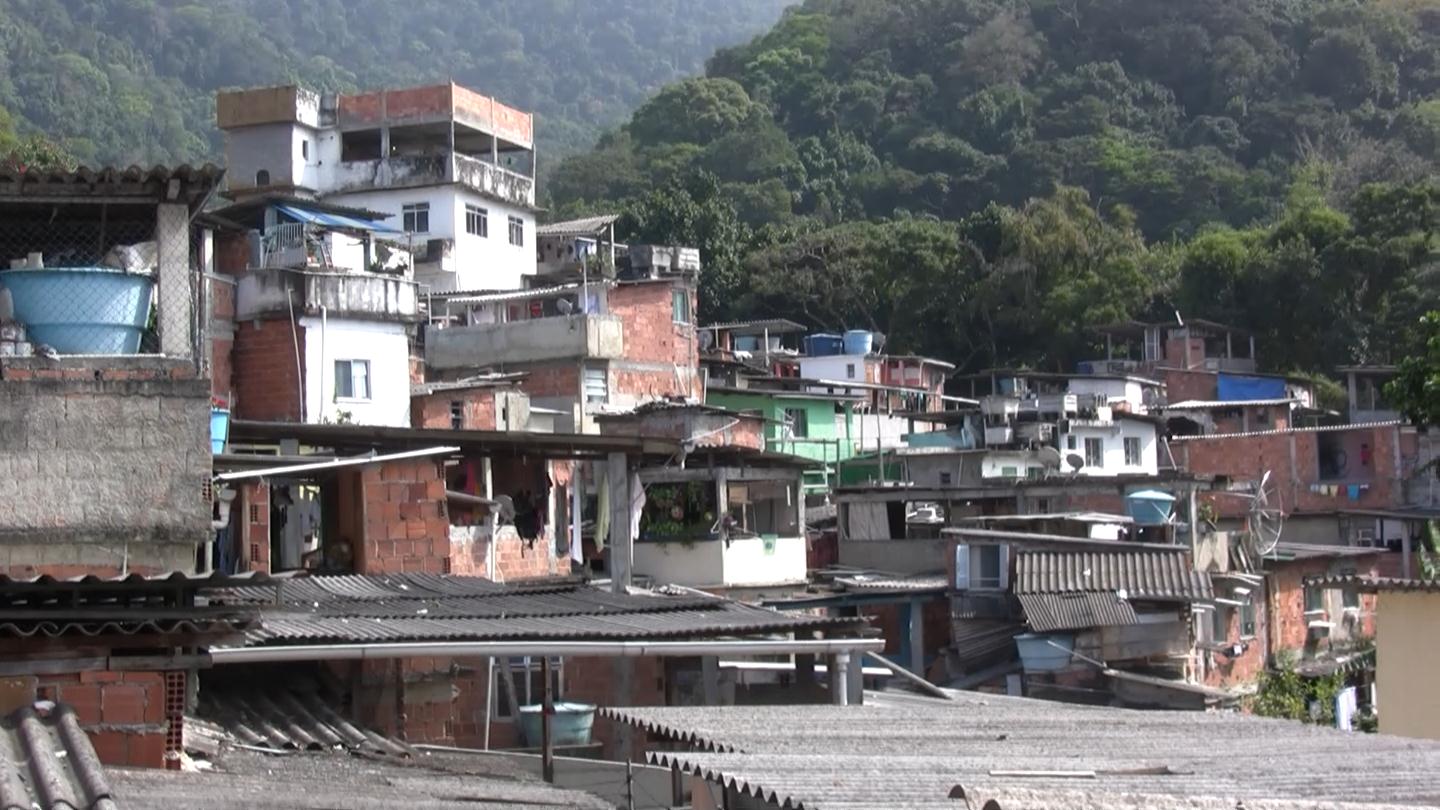 I wanted to see if the city was truly all sunshine and bikini clad women we frequently see in advertisements or whether the other side as depicted in the movie “City of God” was more in-line with the reality. I took an organized tour to two local Favelas which purported to return portions of each tour’s proceeds to the construction of a school – amongst other things. What I found were working class folks who were very prideful and determined to make the best of a trying situation. As my guide put it – very few people are living in ‘misery’ – there aren’t many people begging on the streets – but there are plenty of people willing to sell you arts/crafts/food they made themselves – of which I was happy to oblige. Buildings on top of buildings, the most ingenious splicing of wires and what felt like a ‘make a way’ attitude where pleasant surprises – but didn’t obscure the very dangerous environment of one of the Favelas essentially being run by drug dealers. For me, taking this tour provided me with a different perspective on the city; the beaches and bodies are what’s primarily pushed by the tourism industry (for obvious reasons) – but the reality is it can be a very dangerous place for those who are not aware and not constantly on guard.
I wanted to see if the city was truly all sunshine and bikini clad women we frequently see in advertisements or whether the other side as depicted in the movie “City of God” was more in-line with the reality. I took an organized tour to two local Favelas which purported to return portions of each tour’s proceeds to the construction of a school – amongst other things. What I found were working class folks who were very prideful and determined to make the best of a trying situation. As my guide put it – very few people are living in ‘misery’ – there aren’t many people begging on the streets – but there are plenty of people willing to sell you arts/crafts/food they made themselves – of which I was happy to oblige. Buildings on top of buildings, the most ingenious splicing of wires and what felt like a ‘make a way’ attitude where pleasant surprises – but didn’t obscure the very dangerous environment of one of the Favelas essentially being run by drug dealers. For me, taking this tour provided me with a different perspective on the city; the beaches and bodies are what’s primarily pushed by the tourism industry (for obvious reasons) – but the reality is it can be a very dangerous place for those who are not aware and not constantly on guard. - New Orleans –
I know some people would take offense to calling a US city a slum – but it’s the conditions in the wake of Hurricane Katrina that made it so. Everything from the homelessness and displaced citizens, people dying of disease and starvation and even slum tours of the hardest hit areas. My reason for going was I wanted to see what progress had been made since the disaster. A common refrain from many US citizens is the government has lost its way – that it can no longer do big things or cares to do anything for certain classes of people. At the time of my visit two years after the disaster, the recovery was moving fairly slowly. There were still a ton of FEMA trailers throughout the affected areas, abandoned/unrepaired homes and garbage/debris in the streets. While there was certainly some progress (specifically the new & improved levies) – it seemed most of the visible progress had been made by non-government entities and ordinary people taking matters into their own hands – like the Musician’s Village.
- Soweto –
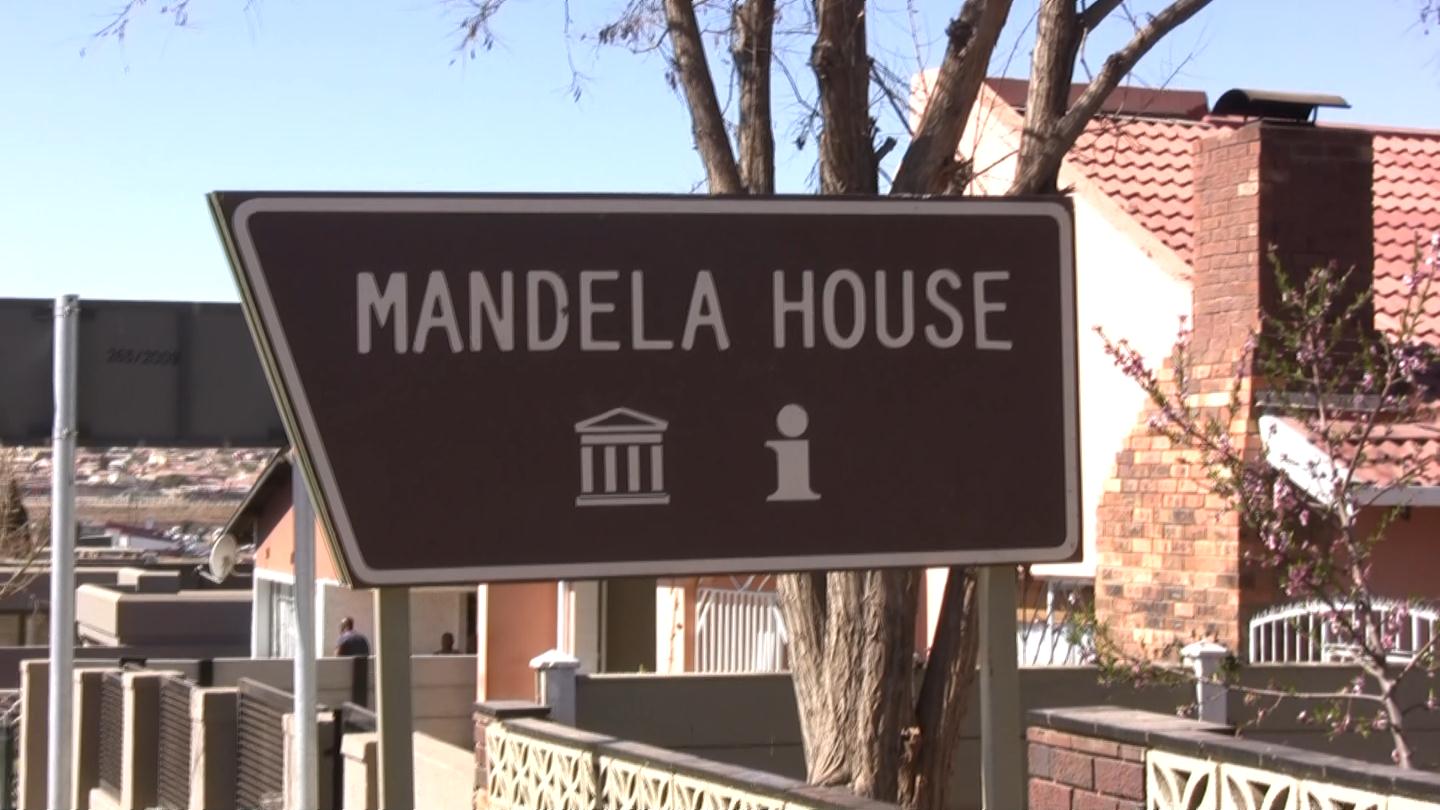 When I was child, there were calls to boycott US businesses that did business in South Africa due to Apartheid – a concept I didn’t even understand. It wasn’t until many many years later that I gained a better understanding of this evil system affecting people who look like me in the ‘Motherland’. I wanted to see the conditions (at least what’s left of them) native South-Africans were forced to endure from the hands of the Dutch, how far the community has come since the fall of Apartheid and how far it has to go in giving its citizens a decent quality of life. Much of South Africa’s history as it relates to Apartheid can be found in and around the community of Soweto – from Mandela’s first house, the Apartheid Museum and the still standing ‘Shantytowns’. An Apartheid leftover, many of these Shantytowns have dirt floors and no inside plumbing. For me, I wasn’t much interested in the Shantytowns themselves (I never entered one) – but the community as a whole. Soweto is often depicted as a giant dangerous eye sore – but is this really the case? Well – yes and no. Yes – there is still a ways to go and it can be dangerous at night. No – in that there are tons of thriving businesses and many of the shantytowns have been replaced by homes that look no different than those on the block I grew up on in the south side of Chicago (window bars and all).
When I was child, there were calls to boycott US businesses that did business in South Africa due to Apartheid – a concept I didn’t even understand. It wasn’t until many many years later that I gained a better understanding of this evil system affecting people who look like me in the ‘Motherland’. I wanted to see the conditions (at least what’s left of them) native South-Africans were forced to endure from the hands of the Dutch, how far the community has come since the fall of Apartheid and how far it has to go in giving its citizens a decent quality of life. Much of South Africa’s history as it relates to Apartheid can be found in and around the community of Soweto – from Mandela’s first house, the Apartheid Museum and the still standing ‘Shantytowns’. An Apartheid leftover, many of these Shantytowns have dirt floors and no inside plumbing. For me, I wasn’t much interested in the Shantytowns themselves (I never entered one) – but the community as a whole. Soweto is often depicted as a giant dangerous eye sore – but is this really the case? Well – yes and no. Yes – there is still a ways to go and it can be dangerous at night. No – in that there are tons of thriving businesses and many of the shantytowns have been replaced by homes that look no different than those on the block I grew up on in the south side of Chicago (window bars and all).
In short, I wanted to have firsthand experience with the subject matter to truly understand the issues at hand. One destination was about exposing the true (at least more nuanced) identify of a culture, another was about progress my government has made to fix its own neglect and the other an historical journey into a dark period of history (I was not aware of the US’ involvement in Apartheid until this trip). These were my reasons, others may agree or disagree as to their validity; no matter – I implore you to think for yourself but be mindful of how you approach the situation.
As a side note, having these personal experiences may make you think about the perspectives you have about your own environment. Here are a few perspectives I have gained/changed due to my travels:
- It always tickles me (not in a good way mind you) when I hear dudes in the US talk about how grimy and rough their ‘block’ is – as they stand on the corner wearing $100 Timberlands and sport jerseys. Please. Don’t get me wrong, poverty is a bitch and exists in full force in the US – but nowhere on the scale as some of the destinations listed above. Just saying most of these dudes need a little perspective.
- How resilient the human spirit is. In all three of my experiences, people continue to strive to make the best out of whatever life throws their way. It’s hard to watch these so called reality TV shows where 10 idiots are thrown into the most contrived situations, whine and complain about the silliest shit and form ad-hoc teams to vote each other out until a winner (I use this term extremely loosely) is determined. It makes me want to drag these assholes off the set of these fake ass shows and throw them in a real 10 person one-room house with no inside plumbing.
- Whenever I see someone touting a “hand-made rug” – the first thing that comes to my mind isn’t “that looks wonderful” – it’s “Slavery”. Though certainly not confined to Egypt – my time spent on the outskirts of Cairo while visiting a rug factory was nothing more than a warehouse full of 6-13 year olds manning various rug making contraptions. You see, little fingers are necessary to properly work the loom and position the material properly. A quick Google search will turn up tons of articles where parents have sold their children into slavery to pay off debts – usually medical bills for the very child sold off. Without seeing this myself, I doubt my reaction to the concept of a rug would be as it is today – even if I’d read it somewhere. Seeing something like this with your own eyes has a more profound effect on one’s psyche – at least I think so.
In Conclusion
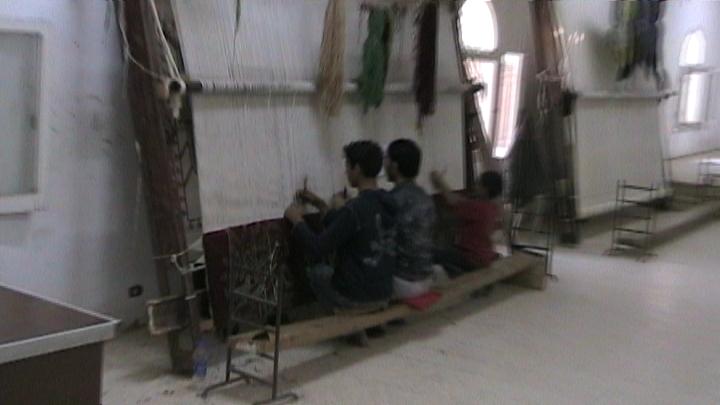
Child Carpet Workers
Will I go on another trip to an impoverished area? Maybe, but certainly not just for the sake of going. I plan on going to India but I don’t have any desire to visit the slums of Mumbai – no matter much Slumdog Millionaire romanticizes it. Actually seeing this particular environment won’t make me feel any better (worse actually), I have no personal or historical connection to the region and I’m not in a position to provide long-term volunteerism. As such, I won’t be talking about the region as if I’m some sort of credible resource on the subject.
| Additional Perspectives |
| NY Times |
| I’m Black and I Travel |
| CNN |
| Wikipedia |
The fact is I don’t see Slum Tourism going anywhere anytime soon. As long as there are people willing to pay to see these environments, there will be some operator willing to offer the tour – whether they give back to the community they are making money off of or not. As I said earlier, this isn’t cable news; I’m not going to tell you whether you should or shouldn’t do something – you’ll need to understand the different perspectives, do additional research (if necessary) and decide if it’s the best thing for you.
Happy Travels!!







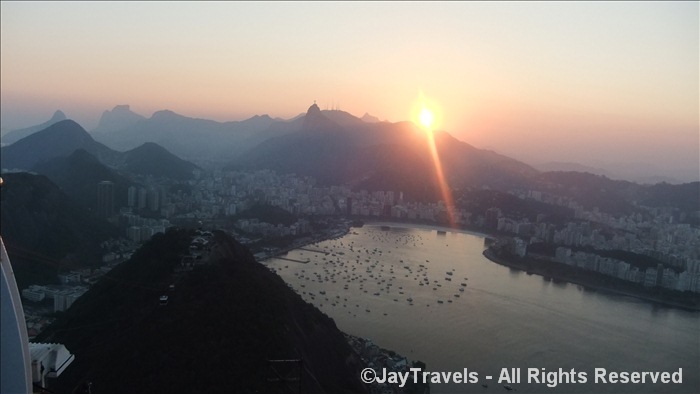







Pingback: La Boca Grita: My trip to Caminito « scottishnomad
Pingback: Favela tourism. Really? | travelola